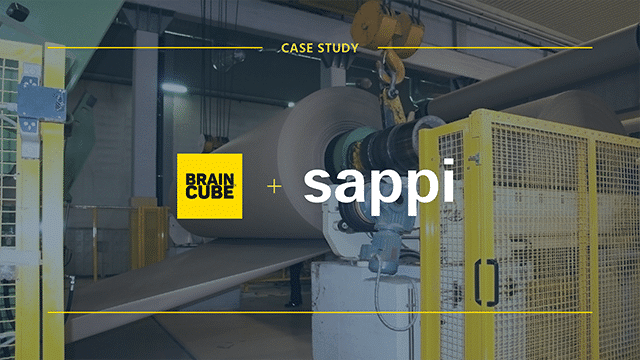Use this guide to learn how paper and packaging manufacturers can improve reliability by scheduling more efficient planned downtime, better condition monitoring, and more with Industry 4.0 tools.
Why is reliability an important KPI for packaging manufacturers?
The simplest way to think about reliability is viewing it as the uptime of your production components. High reliability means everything is working smoothly, there’s no unplanned downtime, processes are optimized, and quality is nearly perfect. In other words, you are maximizing the output of your resources by trimming the fat across multiple aspects of your production process.
This means that reliability isn’t just a readout on the uptime of your equipment and machines. Many manufacturers focus on OEE (Overall Equipment Effectiveness) when measuring their reliability. OEE is a calculation of time, quality, and availability as they relate to the actions of your equipment. Monitoring machine statuses is a valuable part of reliability. It’s usually referred to as condition monitoring. However, it isn’t the only aspect of reliability to consider.
Want to jump to the solution?
If you are only focused on OEE, you are missing out on a key aspect of reliability: Overall Process Effectiveness (OPE). OPE is a measurement of your process efficiency, primarily as it relates to the human aspects of your production. This measurement includes things like employees setting the temperatures for each process, employee operational steps, changes between employee shifts, and other “human elements” that directly impact how your products are made.
Think of it this way: OEE is a readout of the machine factors in your production process. OPE considers the human factors of your production.
The goal of reliability is to maximize both OEE and OPE with your current resources. Manufacturers can do this by reducing waste in both equipment reliability (e.g. unplanned downtime) and process reliability (e.g. ensuring an employee does not run a boiler above the necessary temperature). This gives you a comprehensive view of how your machines are operating and how your employees are operating these machines.

Reliability is more than just the summation of each individual machine’s uptime. Another way to look at reliability is that it is a measurable indication of your overall maintenance. Improving your overall maintenance—of systems, machines, employees, and processes—you can work towards improving your reliability. You’ll need to factor in multiple aspects of your production in order to get a comprehensive view of all the conditions playing into your reliability.
Is reliability the most important manufacturing metric?
It’s tempting to think there is a magical metric that can serve as the guiding light for your manufacturing efforts. But as many manufacturers know, focusing too much on one particular outcome often means jeopardizing another aspect of production.
This is why it’s important to look at reliability as a multi-faceted metric. Since reliability takes into account many different factors, it impacts many different parts of your production. It’s a continuous tug-of-war: as one thing gives, another takes.
Let’s say you currently have high reliability. Things are running smoothly, employees are working in sync, and your final products are passing their quality tests. If you’re only looking at reliability, though, you could be missing out on key aspects of production. Perhaps reliability is high but your output is 30% under quota because you’re slowing down production in order to maximize reliability.
On the flip side, maybe reliability is lower because you’re experiencing more repairs than projected. This might be because you are pushing machines beyond their capacity in order to meet customer demands. Now your output is high and you’re meeting demands, but you’re jeopardizing your uptime in order to hit output goals.
Depending on your current goals and needs, you may opt for one of these (or any other) scenarios over another. This is why it’s crucial to understand how measuring reliability can unlock hidden value for you, as well as its implications.
Reliability: the missing link for paper and packaging manufacturers

As the old adage goes, time is money. This is especially the case in commodity and low-margin products such as paper, tissue, crude oil, and corn. In these industries, it’s all about maximizing production. Run time and output volume essentially determine the revenue these industries make.
Unlike a lot of other solutions aimed at manufacturers these days, though, reliability is something that can often be improved without a large capital investment. It may not cost anything at all to improve reliability.
Instead, you can take a good look at your processes and figure out if something can be optimized to save time or increase speed. This, in turn, also increases your profits because you are producing more product (or reducing how long it takes to produce the same amount of product). You work towards operating with the lowest cost for the highest possible quality.
Minimizing costs and improving uptime
Improving reliability can have a direct impact on cost reduction. If you focus on improving your overall manufacturing reliability, you will also reduce costs. For instance, let’s say that tracking OEE leads you to discover that some machines have more unplanned downtime than others. Perhaps, by planning an additional repair cycle for these machines each quarter, you can minimize your overall unplanned downtime. As a result, you could also improve your overall uptime.
Planned and scheduled maintenance events can cut your downtime drastically, assuming you don’t overdo it. Let’s say you end up with one more planned maintenance event for these machines than you have historically identified. You will likely reduce your unplanned downtime—a huge stressor on your overall reliability measurement.
Planned and scheduled maintenance drastically reduces downtime because you can predict and prevent something before it occurs. Scheduled maintenance also makes it possible to adhere to a more consistent production schedule, flattening the curve on inconsistencies for your production output.
COVID-19 exacerbated the need for paper and packaging manufacturers to run faster, produce more, and reduce unplanned downtime. In addition to higher consumer demand and panic-buying, consumer preferences put additional pressure on manufacturers to crack the code on reliability.
Why is reliability difficult to improve in paper and packaging manufacturing?
As with most manufacturing concepts (e.g. continuous improvement), improving reliability is often easier in concept than in execution. Reliability is tricky enough to improve in most industries, but paper and packaging manufacturers have their own unique challenges. improving reliability is often easier in concept than in execution. Reliability is tricky enough to improve in most industries, but paper and packaging manufacturers have their own unique challenges.
Here are three reasons why it’s difficult for paper and packaging companies to improve reliability.
Older machinery
Even with new technological advancements, the reality is that the majority of paper facilities still run on older machines. According to a recent Fisher report, the regions with the oldest paper and packaging machines are North America and Europe. Dated equipment is inherently less reliable than newer equipment.
Simply purchasing newer production equipment isn’t a feasible solution for most paper and packaging manufacturers. A Fourdrinier can cost millions of dollars even before paying for the removal of old equipment and installation costs for new equipment.
A new machine also has a drastic impact on other parts of your production. You’ll need to reserve a large period of downtime for installation and staff training. Odds are that you’ll also need to recalibrate entire processes after bringing in a different piece of machinery, too.
Breaks happen more frequently with older equipment, leading to greater production uncertainty and jeopardized uptime. Repairs are more frequent and may start to get more costly. Performance may decrease, too.
Another thing to consider with legacy systems is that, sometimes, it can be difficult to integrate with new digital tools, efforts, or programs. Oftentimes, these connectivity issues are a significant barrier to rolling out Industry 4.0 technologies. Integration issues with older equipment can be a major barrier to getting paper manufacturers up and running with IIoT; you’ll need to resolve these before jumping into new tools.
Even so, the reality is that legacy equipment is here to stay.
The ability to better anticipate these breaks and identify issues before they cause downstream problems is a vital way to improve reliability.
Many different machines
Producing paper and packaging products requires many steps across many different machines. The more components you have in your production process, the more failures you’ll have.
Tissue machines run at incredibly high speeds and have a short run time, especially when compared to liquid packaging paper machines. Liquid packaging paper machines are over 1,000 feet long and are incredibly complex. As such, liquid packaging paper machines have a much lower OPE due to the complexity of components, parameters, and human skills required to operate them.
Paper companies are often producing a variety of products, too. White paper, newsprint, kraft paper, and countless other end-products are often made at the same facility. Managing such a vast number of production standards is another challenge for these manufacturers to tackle.
A wide array of product variety means changing and altering processes on a whim. This can lead to unplanned downtime or off production hours. Different end-products often require different equipment or steps, even if some machines are the same for certain processes (pulp washing, defibering, etc.). Calibrating so many different machines can be a major barrier to improving reliability.
If an entirely different machine isn’t required for a new product type, production standards may change between each cycle. Changing the temperature, cutting size, or fiber composition can further complicate reliability metrics and increase traceability difficulty.
Additionally, you must ensure that employees are running each machine within an optimal range to keep OPE high. Maintaining production standards across multiple machines can be difficult for employees to manage. It’s possible that your availability, quality, and performance numbers—the core of OEE metrics—all look great, but something may be causing issues for your employees during the process.
Pressure to produce
Even without the panic buying episodes at the start of the COVID-19 pandemic, most paper mills already ran 24/7. The pandemic took an industry already operating at nearly full capacity and asked paper manufacturers to exceed their top limitations.
In addition, the staffing shortage and aging workforce are continuously taking a heavy toll on the paper industry. While the staffing shortage is a reality for all industries, paper manufacturers tend to have larger barriers to leveling-up new employees. SME knowledge and best practices often lie within each individual’s brain, making it harder to transfer domain knowledge. Digitizing and upskilling your workforce is an ongoing challenge that has a dotted-line impact on reliability.
When you factor in tight margins to this influx of consumer demand, things get tricky. It’s tempting to push your machines and employees to their maximum thresholds in an effort to simply maintain production demands.
This mounting pressure to produce more (and faster) makes even scheduled downtime appear undesirable at times. If everything is running smoothly, it’s tempting to push through a scheduled downtime session in an effort to increase output.
However, pushing the limits between planned downtimes often pushes the limits of reliability (and sometimes safety). This also makes it harder to manage unplanned downtime because unplanned events are, by their very nature, unpredictable.
For example, resetting a press roller can take about six hours. If something goes wrong, though, it may take up to 12 hours to reset. Given the continuous production of papermaking, this downtime essentially halts production and leaves you stuck.
When a machine stops, you may not know what went wrong or how to fix it. You must perform Root Cause Analysis (RCA) before you start addressing the issue. This can be a timely process that might be avoided during a planned downtime, when teams are planning to be available for addressing issues.
Unplanned downtime can also result in unplanned equipment replacement costs. With planned downtime, maintenance teams have more capacity to anticipate repair needs and order the correct parts. Unplanned downtime might require teams to rush-ship a necessary component before production can resume.
Additionally, if you wait until something breaks before fixing it, there is a very real possibility that more than one piece of equipment is ruined. For example, if a pump fails, you may end up also blowing a headbox valve. Now you have two major repairs to complete instead of one.
Lastly, when considering reliability and OPE, unplanned downtime makes it more difficult to make sure the right employees are available to perform repairs. With planned downtime, you can ensure that you have the right teams on hand to quickly make repairs or fine-tune equipment. With unplanned downtime, you may need to pull maintenance team members away from other tasks. The availability of these employees has an impact on reliability: if employees aren’t available when you need them, OPE decreases.
Traditional ways of increasing reliability
Traditionally, manufacturers have used two methodologies to help them improve reliability: condition monitoring and Root Cause Analysis.
Condition monitoring is the process of monitoring certain parts of machinery (e.g. via sensors or vibration detectors) to identify changes that may result in a breakdown, hence requiring a repair. This is a common practice used for building predictive maintenance strategies because maintenance teams can get early detection of something going wrong. These early insights can improve reliability by making it possible to repair a machine early. They may even prevent it from breaking altogether, minimizing the chance that something else goes wrong.
While condition monitoring is a great strategy for maintenance teams to have in their toolbox, it’s certainly not an all-encompassing solution. Having information available that indicates a problem early is useful. Condition monitoring does not always provide teams with a solution to the problem, though. Most of your employees’ time is spent tracking something versus solving something.
Condition monitoring also can’t tell you why something is trending in the wrong direction. This is where another traditional reliability methodology comes into play: Root Cause Analysis (RCA). RCA is “a collective term that describes a wide range of approaches, tools, and techniques used to uncover causes of problems.” These approaches and tools vary drastically depending on the team, problem, and complexity of the problem.
There are a wide variety of RCA techniques and methodologies, but they all have the same key limitation: just because you identify the cause does not mean you are finding a solution.
But what if you could better predict and identify the reasons for a given problem? Or if you could determine the ideal timing for planned downtime? This could save energy by not addressing issues too early. Too much planned downtime minimizes output or results in completing unnecessary, cyclical maintenance. If you had access to these kinds of insights, you could maximize your uptime, throughput, and your human capital.
Here’s how Industry 4.0 and IIoT help you pick up your reliability efforts where these tools leave off.

Keep reading!
Want to see how IIoT helps paper and packaging manufacturers improve reliability, production, and efficiency? Fill out this form to continue reading.



